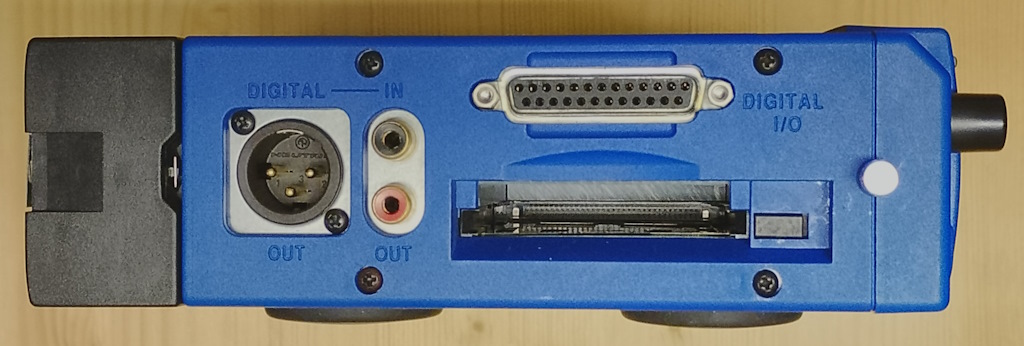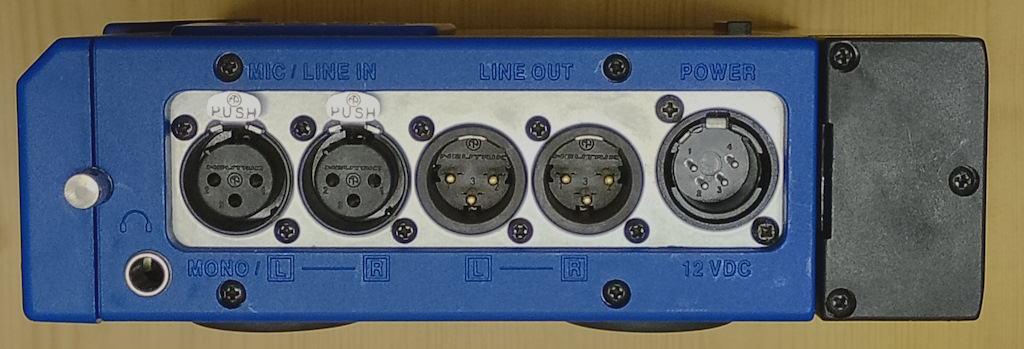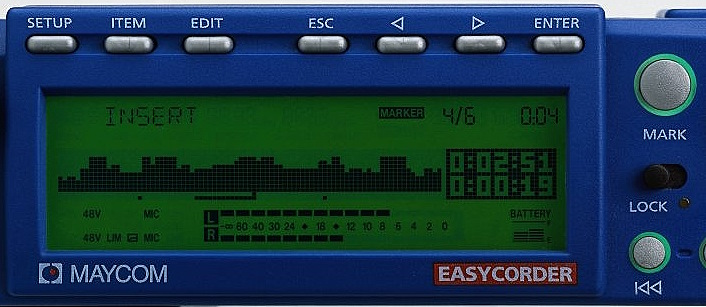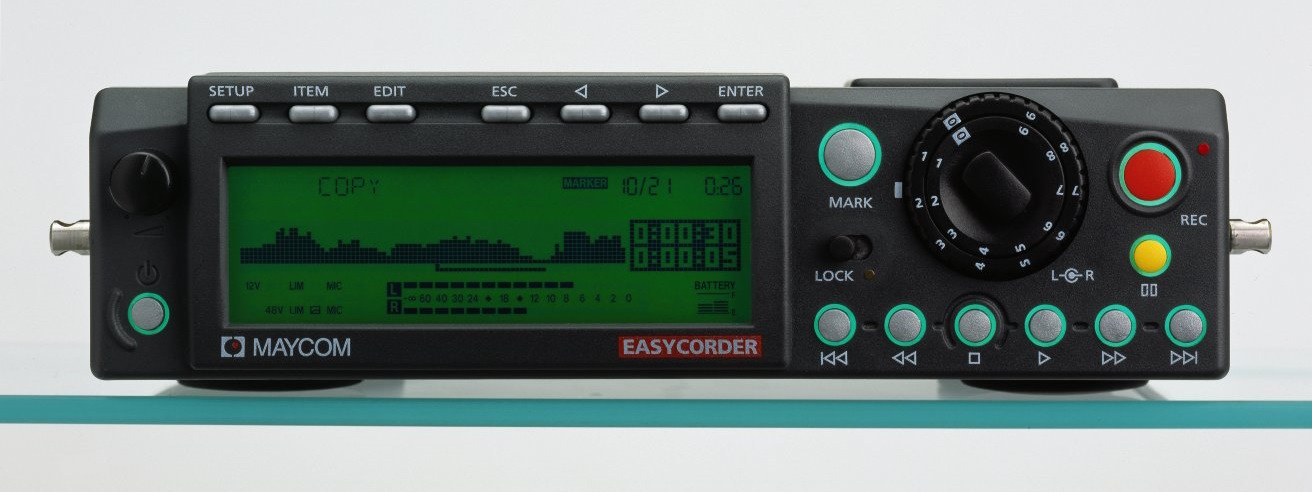In a previous post I wrote about the Maycom Digicorder, which was a very early (likely the first) portable solid state digital recorder. This post caused an owner of a Maycom Easycorder to contact me and send me their (non working) Easycorder. The Easycorder is the product that Maycom created as a follow-up to the Digicorder. It is also one of the products I worked on from the outset together with 4 other technical colleagues. I mainly worked on the low level audio driver and the communication functionality.
Just like with the Digicorder there is not much information on the Internet (although this time there is a snapshot of the Maycom web site on the Wayback machine) so I dived back into my folder of Maycom memorabilia to produce this post.
The design goals
Feedback from Digicorder customers as well as Maycom employees was used to setup the design goals for the Easycorder. Assembly of the Digicorder during manufacturing was rather elaborate and this was one of the points the engineers wanted to address. Customers mentioned that they'd like less weight, longer battery life and lower cost. Another point that customers brought up was the price of the PCMCIA flash card media. At the time a 40MB card could cost anywhere between 500 to 800 US dollars. A MiniDisc with a larger recording time at that time would cost only a couple of dollars. Managers at radio stations were very worried about their staff losing the Digicorder's expensive storage cards.
The Easycorder was going to use MPEG Layer 2 audio compression (just like the Digicorder), which allowed a broadcast quality mono audio file to be compressed to about 1MB per minute. Files were going to use the Broadcast Wave Format, which was in the process of being adopted as the standard for importing audio into radio automation systems.
The solutions
The decision was made to use a more traditional design for the Easycorder. It therefore used plastic and metal for the case and was shaped more like a traditional recorder. This made the recorder much easier to assemble/manufacture and also much lighter since a lot of the Digicorder's weight was due to the heavy duty Nyrim case.
Two versions of the case were chosen, one in a black/grey colour scheme (named "the Classic") and one in a striking blue/silver scheme (named "the Sport"). Most of the people working at Maycom preferred the blue/silver of the sport version, but marketing was worried that the more conservative broadcasters would regard it too toy-like in that colour scheme. This was not an unreasonable view and thus the classic version was added tot he product line. The images below show two Maycom promotional images, one for the "Sport" on the left and one for the "Classic" on the right. Functionality of the two types is 100% identical.
To improve battery life the new recorder was made considerably more power efficient and used a specifically designed battery pack (instead of using an off the shelf one). This ensured that good quality cells with a high quality charging circuit were used, something not always guaranteed with cheap packs from home improvement stores. The new pack not only improved the operation time, it also increased the number of charging cycles each battery pack could handle before losing too much charge.
The Easycorder still features two PCMCIA card slots, but one of these is internal to the recorder and can't be accessed by the user. This was done to alleviate the worry about staff losing an expensive flash card. Since the card was now permanently fixed inside the recorder it could no longer be lost. The second slot is accessible via a slot in the side of the recorder and can be used for recording, but also for file transfer.
Compared to the Digicorder, the cost of the recorder was reduced by using a less expensive chipset, removing the ISDN terminal adapter and making overall manufacturing and assembly easier and less time consuming. The new chipset did not allow the same variable speed playback (so called "scrub editing" or "scrubbing", where a jog wheel is used to set the speed and direction of the audio playback) and editing features were not planned for the recorder, to limit development time and cost to the end user. On the Digicorder the editing functionality was mainly used to limit the size of files before transfer over ISDN and the Easycorder did not have this capability (more about this later).
The result (case design)
Here are some photographs of the Sport version of the Easycorder. The following image shows the front of the recorder. This is the same promotional image that was used earlier to show the difference between the Classic and the Sport version.

All buttons are on the front of the device and there is a mount on each side of the recorder for a shoulder strap. When the recorder is hanging from the user's shoulder all buttons will be facing the user. This makes operation out on the street easy. The power button and the push buttons on the right hand side have a glow ring around them to make them more visible in low-light situations as shown in the image below. Yes, I was quite chuffed when I got the recorded working again!

On the left hand side of the case the digital audio inputs and outputs can be found. Here is also where a an extended capability parallel port is situated that is used for file transfer between the recorder and a Windows PC (or laptop). The largest space on this side of the recorder is taken up by the type-III PCMCIA slot. This slot can be used with flash cards (or hard disks!) to extend the recording time, but the slot can also take communication cards that are then used for file transfer (more on that later). The side of the battery pack is also visible on the left hand side of the image - it goes all the way along the back of the recorder.

On the right hand side of the case the analogue audio connectors live as well as the power input. The outputs are professional line-level balanced outputs. The inputs can be switched between line and microphone, using the built-in mic pre-amp. For microphones there is also the option of switching on 12V or 48V phantom power (which most pro-audio microphones require). There is also a rumble-filter, which is a filter that removes low-frequency noise like the handling of the microphone. Each of these options can be switched on and off via small switches on the top of the unit, independently for each channel.

At the bottom left of the image the headphone socket is visible. The top of the unit also features a small grille behind which a speaker sits.
The result (functionality)
Rather than going through the full list of functions, which would be long and tedious, this section highlights a couple of things that were quite unique to this recorder.
Editing
During the design phase there was a change in management, which caused the requirement for audio editing to be added to the feature list. This was at quite a late stage of the development and happened after the development team had committed the hardware and case design. Adding a jog wheel and changing the chipset to allow for scrub editing was out of the question unfortunately. However, the custom made display did have quite a large graphical section and that allowed a representation of the waveform to be shown. This in turn then allowed the unit to have graphical editing as shown in the photo below:

While the unit is recording the user can press the "Mark" button to place a time marker. In the editor these markers are shown with single dots under the waveform. A line under the audio represents a selection, which can then be cut out or copied and inserted into another location in the same recording, or even edited into a different recording.
Just like with the Digicorder all editing is non-destructive and allows for easy undo functionality. The edit is stored as if it was a separate recording. This is done to ensure that the original recording and the edit are both always directly accessible and makes creating multiple edits from the same recording easy. Edits of edits are of course also possible.
Recording
Apart from recording everything from the moment the record button is pressed until the stop button is pressed there are also two additional recording modes that are designed to limit the amount of the expensive storage used.
The first is "Timeshift" recording, during which the Easycorder captures all audio to an internal buffer of N seconds. The user can specify N to be anything between 20 and 60 seconds. When the buffer is full any new audio added will cause the older audio to be removed so that the buffer always contains the last N seconds of audio captured. As soon as the recording button is pressed again the audio in the buffer is stored at the start of a new file and the recorder keeps recording to the file until the stop button is pressed. The result is that the recorded file can actually start up to N seconds earlier than the record button was pressed. This makes missing the start of a chaotic press conference a thing of the past.
The second is "Smart space" recording. This mode starts the recording when there is audio detected and stops the recording when there has been no audio detected for a while. This limits the amount of storage space wasted on silence or low-level audio.
File transfer
For a radio station to be able to use the recorded audio it needs to be "imported" into their automation system. This is achieved with a Windows program called "EasyCollector" that can receive the audio in a number of different ways.
- Use a flash card in the external card slot of the Easycorder to copy the recordings from the internal storage. Then eject the flash card and put it in the PCMCIA card reader of the PC. This requires the PC to have a PCMCIA card reader installed.
- The Easycorder has an extended capability parallel port that can be used to transfer files over to the PC. This is not particularly fast, but is still considerably faster than playing audio over in real-time as with tape and cassette recorders.
- Using a PCMCIA modem card in the external slot of the Easycorder allows it to connect over a standard analogue telephone line to the modem of the EasyCollector PC. This requires a phone line as well as a modem at the PC end.
- Using a PCMCIA ISDN card in the external slot of the Easycorder allows it to connect over the ISDN network to the EasyCollector PC. This requires an ISDN line as well as an ISDN terminal adapter to have been installed in the PC.
The last two options allow the user of the Easycorder to transfer the recorded audio back to base without having to physically travel there. Nowadays we would use the Internet for that, but in those days access to the Internet was either via dial-up or via ISDN, which made using dial-up/ISDN to connect to base directly much more efficient.
Live audio
Now that we had gone full circle with the Easycorder and implemented a lot of things that were not planned at the beginning, we (the five design engineers) were wondering if we could get the Easycorder to do live real-time audio over ISDN by using an ISDN card in the external PCMCIA slot. As I had most experience with this (I implemented this same thing previously for the Digicorder) it was up to me to have a go at it, but with help of the other engineers as well of course. I remember a chat with a hardware colleague who suggested mixing some audio sources in the CPLD and promptly came up with the goods.
In the end the functionality allowed for a live broadcast quality audio connection over ISDN, including the option to play back recordings while being live on air. The only downside was that the recording had to be made with the same audio compression settings as the ISDN connection was using. A slight hack allowed the user to hear themselves in one ear of their headphones and the sound of the remote side of the connection in the other ear.
Concluding
The Easycorder was introduced at the 1997 International Broadcasting Convention in Amsterdam. It was still a current product when I left the company early 2000 so I'm not entirely sure at what point it was removed from sale. I do know that its successor, the Maycom Handheld recorder, had already been worked on for about a year by then.
Additional information
Part of my old archive of Maycom artefacts is a number of sales brochures and magazine articles from that period. I have scanned some of these and provided the links to PDFs of these scans below:
Easycorder Classic (6MB) - An early brochure showing the Easycorder Classic.
Easycorder Sport (6MB) - A later style brochure showing the Easycorder Sport.
Audio Media article (6MB) - An article about the Easycorder in Audio Media magazine.
What's news 4 (4MB) - Exhibition hand-out showcasing the Easycorder.
 tech.jpg)

